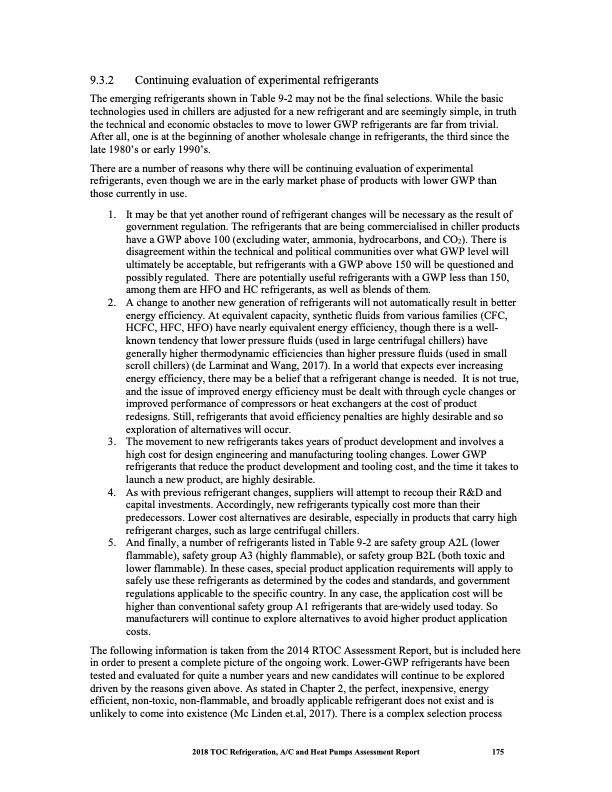
PDF Publication Title:
Text from PDF Page: 188
9.3.2 Continuing evaluation of experimental refrigerants The emerging refrigerants shown in Table 9-2 may not be the final selections. While the basic technologies used in chillers are adjusted for a new refrigerant and are seemingly simple, in truth the technical and economic obstacles to move to lower GWP refrigerants are far from trivial. After all, one is at the beginning of another wholesale change in refrigerants, the third since the late 1980’s or early 1990’s. There are a number of reasons why there will be continuing evaluation of experimental refrigerants, even though we are in the early market phase of products with lower GWP than those currently in use. 1. It may be that yet another round of refrigerant changes will be necessary as the result of government regulation. The refrigerants that are being commercialised in chiller products have a GWP above 100 (excluding water, ammonia, hydrocarbons, and CO2). There is disagreement within the technical and political communities over what GWP level will ultimately be acceptable, but refrigerants with a GWP above 150 will be questioned and possibly regulated. There are potentially useful refrigerants with a GWP less than 150, among them are HFO and HC refrigerants, as well as blends of them. 2. A change to another new generation of refrigerants will not automatically result in better energy efficiency. At equivalent capacity, synthetic fluids from various families (CFC, HCFC, HFC, HFO) have nearly equivalent energy efficiency, though there is a well- known tendency that lower pressure fluids (used in large centrifugal chillers) have generally higher thermodynamic efficiencies than higher pressure fluids (used in small scroll chillers) (de Larminat and Wang, 2017). In a world that expects ever increasing energy efficiency, there may be a belief that a refrigerant change is needed. It is not true, and the issue of improved energy efficiency must be dealt with through cycle changes or improved performance of compressors or heat exchangers at the cost of product redesigns. Still, refrigerants that avoid efficiency penalties are highly desirable and so exploration of alternatives will occur. 3. The movement to new refrigerants takes years of product development and involves a high cost for design engineering and manufacturing tooling changes. Lower GWP refrigerants that reduce the product development and tooling cost, and the time it takes to launch a new product, are highly desirable. 4. As with previous refrigerant changes, suppliers will attempt to recoup their R&D and capital investments. Accordingly, new refrigerants typically cost more than their predecessors. Lower cost alternatives are desirable, especially in products that carry high refrigerant charges, such as large centrifugal chillers. 5. And finally, a number of refrigerants listed in Table 9-2 are safety group A2L (lower flammable), safety group A3 (highly flammable), or safety group B2L (both toxic and lower flammable). In these cases, special product application requirements will apply to safely use these refrigerants as determined by the codes and standards, and government regulations applicable to the specific country. In any case, the application cost will be higher than conventional safety group A1 refrigerants that are widely used today. So manufacturers will continue to explore alternatives to avoid higher product application costs. The following information is taken from the 2014 RTOC Assessment Report, but is included here in order to present a complete picture of the ongoing work. Lower-GWP refrigerants have been tested and evaluated for quite a number years and new candidates will continue to be explored driven by the reasons given above. As stated in Chapter 2, the perfect, inexpensive, energy efficient, non-toxic, non-flammable, and broadly applicable refrigerant does not exist and is unlikely to come into existence (Mc Linden et.al, 2017). There is a complex selection process 2018 TOC Refrigeration, A/C and Heat Pumps Assessment Report 175PDF Image | Heat Pumps Technical Options

PDF Search Title:
Heat Pumps Technical OptionsOriginal File Name Searched:
RTOC-assessment-report-2018_0.pdfDIY PDF Search: Google It | Yahoo | Bing
CO2 Organic Rankine Cycle Experimenter Platform The supercritical CO2 phase change system is both a heat pump and organic rankine cycle which can be used for those purposes and as a supercritical extractor for advanced subcritical and supercritical extraction technology. Uses include producing nanoparticles, precious metal CO2 extraction, lithium battery recycling, and other applications... More Info
Heat Pumps CO2 ORC Heat Pump System Platform More Info
| CONTACT TEL: 608-238-6001 Email: greg@infinityturbine.com | RSS | AMP |